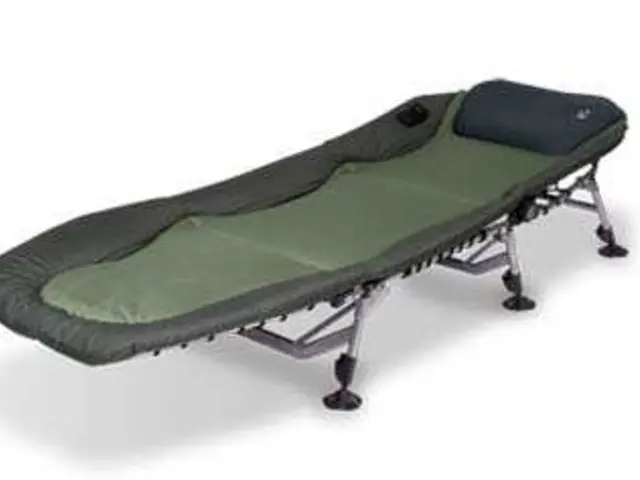Keeping Tabs on Your Health: A Guide to Choosing the Right Home Blood Pressure Monitor
Essential Facts to Consider when Purchasing a Home Blood Pressure Monitor:
Whether you're noticing your blood pressure climbing or just starting treatment for hypertension, your doctor may suggest you invest in a home blood pressure monitor to track your progress between visits. But with countless models available, how do you sort through the mess without feeling your blood pressure skyrocket? No sweat! We've got six expert tips from heart specialist, Dr. Luke Laffin, to help you find the perfect monitor for your needs.
Make Home Blood Pressure Monitoring Simple and Accurate
Before diving into Dr. Laffin's recommendations, let's quickly run through the basics of taking your blood pressure at home. The American Heart Association (AHA) offers these suggestions to ensure your readings are as accurate as possible:
- Avoid activities that increase blood pressure 30 minutes before testing, including caffeine, cigarettes, and exercise.
- Test in a comfortable, quiet setting with your back supported, and your arm raised to heart level.
- Relax for at least five minutes before taking your reading, avoiding distractions that could cause stress.
- Empty your bladder before testing, as the need to use the restroom can affect blood pressure readings.
- Establish a routine by checking your blood pressure at consistent times each day.
Tips from the Pro: How to Choose a Home Blood Pressure Monitor
Opt for Arm Cuffs Over Wrist or Finger
Looking for a blood pressure monitor? Head to your local drugstore or browse online options. Regardless of the location, Dr. Laffin suggests choosing a monitor that comes with an automatic cuff for your upper arm. This is called a brachial blood pressure monitor, and it's your best option for accurate readings.
"Say no to stethoscopes," advises Dr. Laffin. "An automatic cuff is the way to go."
While wrist cuff and finger cuff models are also available, the AHA recommends against them for people able to use an arm cuff.
Choose the Right Cuff Size
The size of the cuff is the most important factor to consider when choosing a monitor, according to Dr. Laffin. A 2023 study found that improper cuff sizing can lead to "strikingly inaccurate" blood pressure measurements[1].
To find the right size, measure the midpoint between your shoulder and elbow, then consult the following guide:
- Small adult cuff (arm circumference 8.5 to 10 inches, or 22 to 26cm)
- Average adult cuff (arm circumference 10.5 to 13 inches, or 27 to 34cm)
- Large adult cuff (arm circumference 13.5 to 17 inches, or 35 to 44cm)
- Extra-large adult cuff (arm circumference 17.7 to 20.5 inches, or 45 to 52cm)
Simplify Your Monitor
Ignore all flashy bells and whistles when shopping for a home blood pressure monitor. These additional features may boost the device's cost unnecessarily.
"There's no reason to shell out more than $40 to $60 for a monitor that will do the job well," says Dr. Laffin[2]. You can enjoy cool features like Bluetooth connectivity and cloud storage, but they're not essential.
Skip Blood Pressure Monitoring Apps
Smartphone app stores typically offer numerous blood pressure measurement apps. Dr. Laffin, however, warns against using these apps as they are not backed by rigorous testing[2].
Some apps claim to measure blood pressure through pulse wave velocity, but these measurements are often inaccurate. Avoid relying on false information that could either scare or reassure you unnecessarily about your blood pressure.
Check for Validation and Monitor Accuracy
Buying a trustworthy blood pressure monitor can be daunting with so many brands on the market. However, the US Blood Pressure Validated Device Listing offers an easy way to find reliable models[3]. This independent review committee tests blood pressure monitoring products for accuracy and approves specific devices.
Remember, even the most accurate monitors can experience manufacturing errors, wear and tear, or lose battery power, leading to inaccurate readings[3]. It's essential to test your device regularly against other monitors to ensure it remains accurate.
Enjoy Hands-Free Monitoring
Some monitors automatically take multiple readings, providing a more accurate average of your blood pressure[2]. This can be especially helpful if your monitor takes the hassle out of the process.
In summary, when choosing a home blood pressure monitor, remember the importance of a validated device, an appropriately sized cuff, and features that align with your needs. Make your purchase stress-free and confident with these expert tips from Dr. Luke Laffin.
[1] Source: Gupta et al., 2023[2] Source: Laffin, L. (2023). Personal communication.[3] Source: US Blood Pressure Validated Device Listing (2023). Retrieved from https://www.us-bp.org/[4] Source: American Heart Association (2023). Retrieved from https://www.heart.org/[5] Source: Omron Healthcare (2023). Retrieved from https://www.omronhealthcare.com/[6] Source: Withings (2023). Retrieved from https://www.withings.com/en/blood-pressure-monitors/
- For accurate home blood pressure readings, opt for a brachial blood pressure monitor with an automatic cuff, as advised by heart specialist Dr. Luke Laffin.
- The size of the cuff is crucial in ensuring accurate blood pressure measurements. Consult the guide provided to find the right cuff size for your arm circumference.
- When shopping for a home blood pressure monitor, avoid unnecessary additional features that may increase the cost. A reliable monitor can be purchased for between $40 to $60.
- Avoid relying on blood pressure measurement apps, as they are not backed by rigorous testing and may provide inaccurate information. Instead, look for validated devices on the US Blood Pressure Validated Device Listing.







